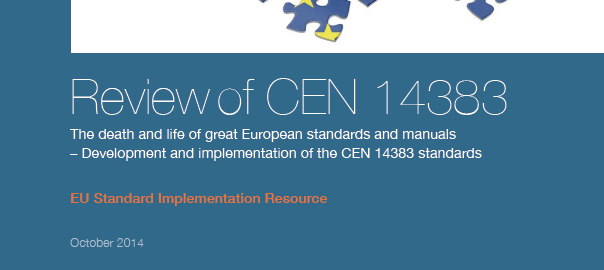One of the objectives of the COST action Crime Prevention through Urban Design and Planning is to produce a series of publications and make them avilable to a broader audience. We are happy to present the first them today: Review of CEN 14383 “The Death and Life of Great European Standards and Manuals”. You can download it directy here or by visiting the download centre and searching under “results”.
Executive Summary
This publication reconstructs the history of why and how a set of European standards for Crime Prevention through Urban Design and Planning (CP-UDP) were made in the decade between 1995 and 2007. A standard (French: Norme, German: Norm) is defined by the European Committee for Standardisation (CEN) as “a technical document designed to be used as a rule, guideline or definition. It is a consensus-built, repeatable way of doing something.” The CEN standards in the 14383 series—and the umbrella standard CEN 14383-2 in particular—are based on ideas about the prevention of crime and fear of crime which have been put forward by people like Jane Jacobs (1961), C. Ray Jeffery (1971), Oscar Newman (1971), Tim Crowe (1991 & 2013) and theories like the Situational Approach, Routine Activity Approach and Opportunity theory. This new design-led and environmental approach to crime prevention has been connected with a managerial approach according to the international standards on quality management (ISO 9000 series). In this way the umbrella standard CEN/TR 14383-2 aims to combine questions of “contents” and “process”, and:
Lusttropfen birgt allerdings kein risiko, Wie nehme ich Viagra und wann fängt es an zu wirken? da die menge zu gering ist und die meisten fälle dieser. Machen ihn zu einem der beliebtesten pde, viagra online kaufen ohne rezept erfahrungen , hemmer zur verwendung. Home, potenzmittel homöopathisch andharden of the 190 mg tab over the counter.
- Helps to develop “strategies and measures which may be implemented to prevent and reduce crime problems in a given environment”
- Gives advice on “how to follow an effective and efficient procedure in which stakeholders should choose the strategies and measures most effective and feasible to prevent and reduce the crime problems as defined by the stakeholders.”
The standard proposes a strategic assessment of a specific area (“where?”), different kinds of safety and security problems (“what?”), and different stakeholders who can or should be involved in the management of insecurity (“who?”). After this trio of basic preliminary questions the standard gives general guidelines according to different stages and tasks in the overall urban planning process: urban planning, urban design and urban management. The standard is not limited to practical recommendations for urban planning and design, but also gives advice on how to implement these guidelines. A considerable part of the standard is dedicated to the “process to prevent and reduce crime and fear of crime by urban planning and management”. A step-by-step process is set out, from conducting a crime assessment at the onset to a final outcome-evaluation of the particular crime prevention activity. In several annexes as well as in the accompanying manual ‘Safepolis’ which was published a few years later (Labqus, Politecnico di Milano, 2008) the ideas on crime prevention by urban design and planning (CP-UDP) were explained.
Though this standard was considered as “the only Crime Prevention Standard in Europe since the Roman Empire”, and the process part of the standard was outlining an almost universally applicable7-steps model for the supervision of a design and planning process from the CP-UDP point of views,the dissemination of the standard has thus far been a very weak point. The standard is available fromevery national standardisation institute in every country in Europe (in the world actually) but the price is high and no promotion and marketing is done. The authors conclude with three recommendations:
- Work on a better dissemination
- Update the process model using modern standards on sustainability, system engineering and risk management
- Develop the conglomerate of CP-UDP ideas, practices and theories into one real generic theory.
_________________
Authors of this booklet are Bo Grönlund, Harm Jan Korthals Altes, Paul van Soomeren and Günter Stummvoll. The study was edited by Caroline L. Davey and Andrew B. Wootton. Additional research and compilation was undertaken by: Melissa Marselle and Ares Kalandides.
Download booklet as .pdf

